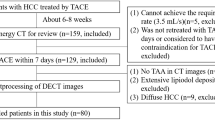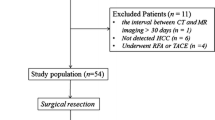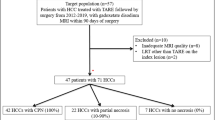Abstract
Background
The purpose of this study was to assess the accuracy of double-contrast magnetic resonance (MR) imaging for the treatment response evaluation of hepatocellular carcinoma (HCC) in cirrhotic liver after transarterial chemoembolization (TACE).
Methods
Twenty-two patients with 30 HCC nodules treated by TACE underwent double-contrast MR imaging 1 month after treatment. MR images were obtained before and after the sequential administration of superparamagnetic iron oxide (SPIO) and gadopentetate dimeglumine contrast agent within the same imaging session. Two observers retrospectively assessed all treated nodules for evidence of residual viable tumor after TACE. The diagnostic performance of gadolinium-enhanced, SPIO-enhanced, and double-contrast enhanced images was calculated. Histopathological and angiographical findings served as standard of reference. Receiver operating characteristic curves and areas under the curves (A z) were calculated.
Results
Double-contrast technique (A z = 0.95) was significantly (p = 0.036) more accurate than SPIO-enhanced technique (A z = 0.92) and gadolinium-enhanced technique (p = 0.005) (A z = 0.81) in viable tumor detection after TACE. Double-contrast technique was significantly more sensitive (92%) than SPIO-enhanced technique (80%) and gadolinium-enhanced technique (68%). Kappa values for interobserver agreement ranged from 0.67 to 0.87 and were significantly different from zero (all p < 0.001).
Conclusions
Compared to gadolinium-enhanced and SPIO-enhanced techniques, double-contrast technique significantly improves the detection of viable tumor in HCC after TACE.





Similar content being viewed by others
References
Bruix J, Llovet JM (2002) Prognostic prediction and treatment strategy in hepatocellular carcinoma. Hepatology 35:519–524
Llovet JM, Bru C, Bruix J (1999) Prognosis of hepatocellular carcinoma: the BCLC staging classification. Semin Liver Dis 19:329–338
Ito K, Honjo K, Fujita T, et al. (1995) Therapeutic efficacy of transcatheter arterial chemoembolization for hepatocellular carcinoma: MRI and pathology J Comput Assist Tomogr 19:198–203
Ward J, Guthrie JA, Scott DJ, et al. (2000) Hepatocellular carcinoma in the cirrhotic liver: double-contrast MR imaging for diagnosis Radiology 216:154–162
Earls JP, Rofsky NM, DeCorato DR, Krinsky GA, Weinreb JC (1997) Hepatic arterial-phase dynamic gadolinium-enhanced MR imaging: optimization with a test examination and a power injector Radiology 202:268–273
Castrucci M, Sironi S, De Cobelli F, Salvioni M, Del Maschio A (1996) Plain and gadolinium-DTPA-enhanced MR imaging of hepatocellular carcinoma treated with transarterial chemoembolization Abdom Imaging 21:488–494
Yoshioka H, Nakagawa K, Shindou H, et al. (1990) MR imaging of the liver before and after transcatheter hepatic chemo-embolization for hepatocellular carcinoma Acta Radiol 31:63–67
Landis JR, Koch GG (1977) An application of hierarchical kappa-type statistics in the assessment of majority agreement among multiple observers Biometrics 33:363–374
Imaeda T, Yamawaki Y, Seki M, et al. (1993) Lipiodol retention and massive necrosis after lipiodol-chemoembolization of hepatocellular carcinoma: correlation between computed tomography and histopathology Cardiovasc Intervent Radiol 16:209–213
Matsui O, Kadoya M, Yoshikawa J, Gabata T, Takashima T, Demachi H (1994) Subsegmental transcatheter arterial embolization for small hepatocellular carcinomas: local therapeutic effect and 5-year survival rate Cancer Chemother Pharmacol 33(suppl):S84–S88
Choi BI, Kim HC, Han JK, et al. (1992) Therapeutic effect of transcatheter oily chemoembolization therapy for encapsulated nodular hepatocellular carcinoma: CT and pathologic findings Radiology 182:709–713
Kenji J, Hyodo I, Tanimizu M, et al. (1997) Total necrosis of hepatocellular carcinoma with a combination therapy of arterial infusion of chemotherapeutic lipiodol and transcatheter arterial embolization: report of 14 cases Semin Oncol 24:S6-71–S76-80
Miller DL, O’Leary TJ, Girton M (1987) Distribution of iodized oil within the liver after hepatic arterial injection Radiology 162:849–852
Takayasu K, Shima Y, Muramatsu Y, et al. (1987) Hepatocellular carcinoma: treatment with intraarterial iodized oil with and without chemotherapeutic agents Radiology 163:345–351
Takayasu K, Arii S, Matsuo N, et al. (2000) Comparison of CT findings with resected specimens after chemoembolization with iodized oil for hepatocellular carcinoma AJR Am J Roentgenol 175:699–704
Okusaka T, Okada S, Ueno H, et al. (2000) Evaluation of the therapeutic effect of transcatheter arterial embolization for hepatocellular carcinoma Oncology 58:293–299
Nishimine K, Uchida H, Matsuo N, et al. (1994) Segmental transarterial chemoembolization with Lipiodol mixed with anticancer drugs for nonresectable hepatocellular carcinoma: follow-up CT and therapeutic results Cancer Chemother Pharmacol 33(suppl):S60–S68
Murakami R, Yoshimatsu S, Yamashita Y, Sagara K, Arakawa A, Takahashi M (1994) Transcatheter hepatic subsegmental arterial chemoembolization therapy using iodized oil for small hepatocellular carcinomas. Correlation between lipiodol accumulation pattern and local recurrence Acta Radiol 35:576–580
Vogl TJ, Trapp M, Schroeder H, et al. (2000) Transarterial chemoembolization for hepatocellular carcinoma: volumetric and morphologic CT criteria for assessment of prognosis and therapeutic success-results from a liver transplantation center Radiology 214:349–357
Minami Y, Kudo M, Kawasaki T, et al. (2003) Transcatheter arterial chemoembolization of hepatocellular carcinoma: usefulness of coded phase-inversion harmonic sonography AJR Am J Roentgenol 180:703–708
Sze DY, Razavi MK, So SK, Jeffrey RB Jr (2001) Impact of multidetector CT hepatic arteriography on the planning of chemoembolization treatment of hepatocellular carcinoma AJR Am J Roentgenol 177:1339–1345
Koito K, Namieno T, Ichimura T, et al. (2000) Power Doppler sonography: evaluation of hepatocellular carcinoma after treatment with transarterial embolization or percutaneous ethanol injection therapy AJR Am J Roentgenol 174:337–341
Cioni D, Lencioni R, Bartolozzi C (2000) Therapeutic effect of transcatheter arterial chemoembolization on hepatocellular carcinoma: evaluation with contrast-enhanced harmonic power Doppler ultrasound Eur Radiol 10:1570–1575
Sumi S, Yamashita Y, Mitsuzaki K, et al. (1999) Power Doppler sonography assessment of tumor recurrence after chemoembolization therapy for hepatocellular carcinoma AJR Am J Roentgenol 172:67–71
Murakami T, Nakamura H, Hori S, et al. (1993) Detection of viable tumor cells in hepatocellular carcinoma following transcatheter arterial chemoembolization with iodized oil. Pathologic correlation with dynamic turbo-FLASH MR imaging with Gd-DTPA. Acta Radiol 34:399–403
Lagalla R, Caruso G, Finazzo M (1998) Monitoring treatment response with color and power Doppler Eur J Radiol 27(suppl 2):S149–S156
Youk JH, Lee JM, Kim CS (2003) Therapeutic response evaluation of malignant hepatic masses treated by interventional procedures with contrast-enhanced agent detection imaging J Ultrasound Med 22:911–920
Murakami T, Nakamura H, Tsuda K, et al. (1993) Treatment of hepatocellular carcinoma by chemoembolization: evaluation with 3DFT MR imaging AJR Am J Roentgenol 160:295–299
Kubota K, Hisa N, Nishikawa T, et al. (2001) Evaluation of hepatocellular carcinoma after treatment with transcatheter arterial chemoembolization: comparison of Lipiodol-CT, power Doppler sonography, and dynamic MRI Abdom Imaging 26:184–190
De Santis M, Alborino S, Tartoni PL, Torricelli P, Casolo A, Romagnoli R (1997) Effects of lipiodol retention on MRI signal intensity from hepatocellular carcinoma and surrounding liver treated by chemoembolization Eur Radiol 7:10–16
Sakurai M, Okamura J, Kuroda C (1984) Transcatheter chemo-embolization effective for treating hepatocellular carcinoma. A histopathologic study Cancer 54:387–392
Marukawa T, Harada K, Kuruda C (1987) MRI of the resected hepatocellular carcinoma specimens following trans-catheter arterial embolization. Comparison with pathologic findings (Abstract). In: 5th Asian oceanian congr radiol, vol 47
Yan FH, Zhou KR, Cheng JM, et al. (2002) Role and limitation of FMPSPGR dynamic contrast scanning in the follow-up of patients with hepatocellular carcinoma treated by TACE World J Gastroenterol 8:658–662
Ohtomo K, Itai Y, Yoshikawa K, Yashiro N, Kokubo T, Iio M (1986) MR imaging of hepatoma treated by embolization J Comput Assist Tomogr 10:973–975
Noguchi Y, Murakami T, Kim T, et al. (2003) Detection of hepatocellular carcinoma: comparison of dynamic MR imaging with dynamic double arterial phase helical CT AJR Am J Roentgenol 180:455–460
Author information
Authors and Affiliations
Corresponding author
Rights and permissions
About this article
Cite this article
Bolog, N., Pfammatter, T., Müllhaupt, B. et al. Double-contrast magnetic resonance imaging of hepatocellular carcinoma after transarterial chemoembolization. Abdom Imaging 33, 313–323 (2008). https://doi.org/10.1007/s00261-007-9244-y
Published:
Issue Date:
DOI: https://doi.org/10.1007/s00261-007-9244-y




